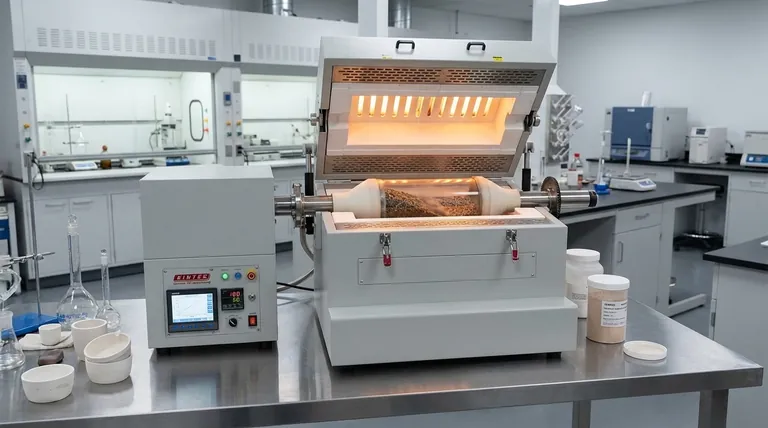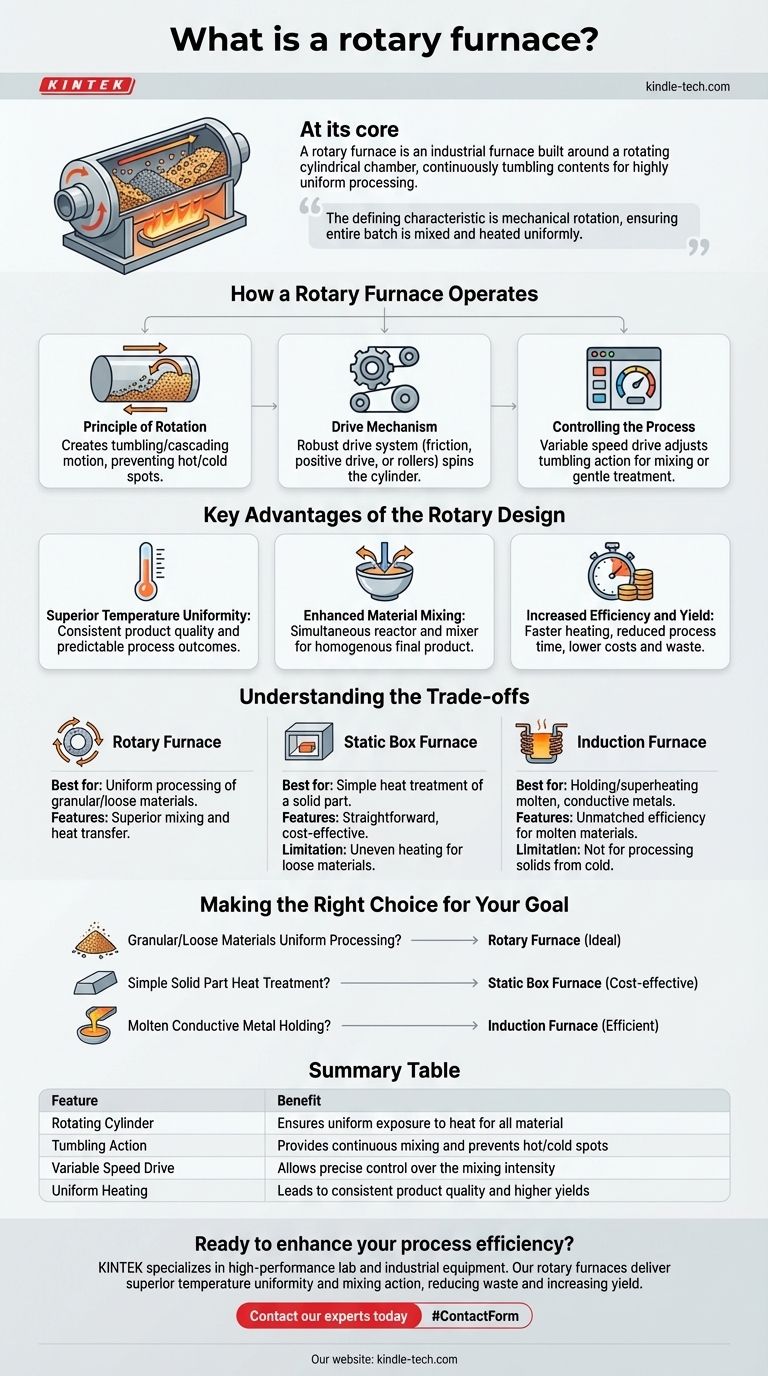At its core, a rotary furnace is an industrial furnace built around a rotating cylindrical chamber. Unlike a static furnace where the material sits still, a rotary furnace continuously tumbles its contents, ensuring every part of the material is consistently exposed to the heat source. This fundamental design is engineered to achieve highly uniform processing conditions.
The defining characteristic of a rotary furnace is its mechanical rotation. This design directly solves the common industrial challenge of uneven heating by ensuring the entire batch of material is mixed and heated uniformly.

How a Rotary Furnace Operates
To understand its value, you must first understand its mechanics. The operation is simple in concept but relies on precise engineering for control and reliability.
The Principle of Rotation
The primary purpose of the rotation is to create a tumbling or cascading motion within the material charge. As the cylinder rotates, the material is lifted and then falls back onto itself.
This continuous movement ensures that no single part of the material remains isolated at the core or stuck to the furnace wall, preventing hot and cold spots.
The Drive Mechanism
The rotation is managed by a robust drive system. The specific design depends on the furnace's size and the weight of the material it will process.
Common drive systems include a friction drive, where drive wheels spin the cylinder, or a positive drive using a rack-and-pinion or chain-and-sprocket system for heavier-duty applications. In some configurations, the cylinder simply rests on and is turned by a set of powered rollers.
Controlling the Process
Modern rotary furnaces offer precise control over the processing environment. The rotational speed is typically managed by a variable speed drive.
This allows operators to adjust the tumbling action based on the material's properties—a faster rotation for aggressive mixing or a slower speed for more gentle treatment. The direction of rotation can often be reversed to further enhance mixing.
Key Advantages of the Rotary Design
The decision to use a rotary furnace is driven by the significant process advantages its unique design offers over static alternatives.
Superior Temperature Uniformity
The constant tumbling is the most effective way to achieve a uniform temperature throughout a batch of loose or granular material. This leads to a more consistent product quality and predictable process outcomes.
Enhanced Material Mixing
For processes that require blending different materials or ensuring a homogenous final product, the rotary furnace's inherent stirring action is a major benefit. It serves as both a reactor and a mixer simultaneously.
Increased Efficiency and Yield
Uniform heating is fast heating. By constantly exposing new surfaces to the heat, the process time can be reduced. This efficiency, combined with fewer rejected batches from uneven processing, helps lower overall production costs and material waste.
Understanding the Trade-offs
While powerful, a rotary furnace is not the universal solution for all heating applications. Understanding its context is key to proper selection.
Rotary vs. Static Box Furnaces
A box furnace is a simple, static chamber. It is excellent for heating single, solid objects or for batch processes where material movement is not required or desired.
However, when processing powders, granules, or other loose materials in a box furnace, the outer layers can insulate the core, leading to significant temperature differences within the batch. A rotary furnace is specifically designed to overcome this limitation.
Rotary vs. Induction Furnaces
An induction furnace operates on a completely different principle, using electromagnetic fields to generate heat directly within conductive materials.
A channel induction furnace, for example, is highly efficient for holding or superheating already molten metals like cast iron. It is not typically used for processing solids from a cold state. A rotary furnace, conversely, is extremely versatile for processing a wide range of solids, including heat treatment, drying, and calcination.
Making the Right Choice for Your Goal
Selecting the correct furnace technology requires aligning the equipment's core strengths with your specific process requirements.
- If your primary focus is uniform processing of granular or loose materials: A rotary furnace is the ideal choice due to its superior mixing and heat transfer.
- If your primary focus is simple heat treatment of a solid part: A static box furnace is often the more straightforward and cost-effective solution.
- If your primary focus is holding or superheating already molten, conductive metals: An induction furnace offers unmatched efficiency for this specific task.
Ultimately, choosing the right furnace is about matching the tool's fundamental operating principle to the problem you need to solve.
Summary Table:
| Feature | Benefit |
|---|---|
| Rotating Cylinder | Ensures uniform exposure to heat for all material |
| Tumbling Action | Provides continuous mixing and prevents hot/cold spots |
| Variable Speed Drive | Allows precise control over the mixing intensity |
| Uniform Heating | Leads to consistent product quality and higher yields |
Ready to enhance your process efficiency and product consistency?
KINTEK specializes in high-performance lab and industrial equipment. Our rotary furnaces are engineered to deliver the superior temperature uniformity and mixing action your granular material processing requires, helping you reduce waste and increase yield.
Contact our experts today to discuss how a KINTEK rotary furnace can be the solution for your specific application!
Visual Guide

Related Products
- Rotary Tube Furnace Split Multi Heating Zone Rotating Tube Furnace
- Electric Rotary Kiln Small Rotary Furnace for Activated Carbon Regeneration
- Laboratory Vacuum Tilt Rotary Tube Furnace Rotating Tube Furnace
- Vacuum Sealed Continuous Working Rotary Tube Furnace Rotating Tube Furnace
- 1700℃ Laboratory Quartz Tube Furnace with Alumina Tube Tubular Furnace
People Also Ask
- What are the advantages of a rotary furnace? Achieve Superior Homogeneity & Efficiency for Powders & Granules
- What are the typical heating zone configurations and maximum temperature capabilities of tube furnaces? Find the Right Setup for Your Lab
- What is the temperature of a rotary hearth furnace? Find the Right Heat for Your Process
- What is a rotary heat type furnace? The Ultimate Guide to Uniform Heating & Mixing
- What are the disadvantages of rotary kiln incinerator? High Costs and Operational Complexities



















